
St. Canute's Cathedral, also known as Odense Cathedral, is named after the Danish king Canute the Saint, otherwise Canute IV. It is a fine example of Brick Gothic architecture. The church's most visited section is the crypt where the remains of Canute and his brother Benedict are on display.
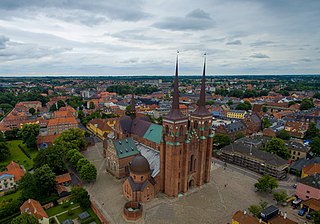
Roskilde Cathedral, in the city of Roskilde on the island of Zealand (Sjælland) in eastern Denmark, is a cathedral of the Lutheran Church of Denmark.

Nørrebrogade is the principal shopping street of the Nørrebro district of Copenhagen, Denmark. It runs from The Lakes in the southeast to Nørrebro station in the northwest, linking Frederiksborggade and Queen Louise's Bridge with Frederikssundsvej. The street passes Assistens Cemetery, Nørrebro Runddel and the Superkilen linear park. Buildings include the multipurpose venue Nørrebrohallen and two churches.
The 1964 Danish 1st Division was the 37th season of Denmark's top-flight association football division since the establishment of Danmarksturneringen's nation-wide league structure in 1927, and the 51st edition of the overall Danish national football championship since its inception in 1912. Governed by the Danish FA, the season was launched on 26 March 1964 with a clash between last season's third-placed B 1903 and Østerbro-based and local rivals B.93 with the last round of six matches concluding on 15 November 1964. Esbjerg fB were the defending league champions, having won their third consecutive league title last season, while BK Frem and B.93 entered as promoted teams from the 1963 Danish 2nd Division. Fixtures for the 1964 season were announced by the Danish FA's tournament committee on 6 January 1964, featuring a nine weeks long summer break.

Esbjerg is a seaport city and seat of Esbjerg Municipality on the west coast of the Jutland peninsula in southwest Denmark. By road, it is 71 kilometres (44 mi) west of Kolding and 164 kilometres (102 mi) southwest of Aarhus. With an urban population of 71,505 it is the fifth-largest city in Denmark, and the largest in West Jutland.

Växjö Cathedral is a cathedral in Växjö, Sweden. It is the seat of the Bishop of Växjö within the Church of Sweden. According to legend, the cathedral was founded by Saint Sigfrid of Sweden. The first stone church on the site, parts of which are incorporated into the current cathedral, was built in the 1160s. The cathedral has been much altered over time, and its appearance today is largely the result of a far-reaching restoration carried out in the 1950s under the guidance of architect Kurt von Schmalensee. Växjö Cathedral is a hall church with a western tower and a square choir. It was built on a location which was probably used as a marketplace during pre-Christian times. Very few of the cathedral's original furnishings have survived from earlier centuries; most of the works of art adorning the cathedral date from the 20th or 21st centuries, and many of them are made of glass.
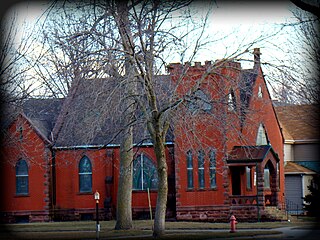
Trinity Memorial Episcopal Church is a former parish church in the Episcopal Diocese of Iowa. The historic building is located in Mapleton, Iowa, United States. It was listed on the National Register of Historic Places in 1990. The former church building and hall now house the Museum of American History.
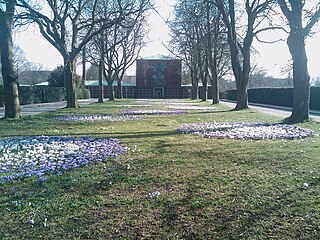
Søndermark Cemetery is a cemetery in the Frederiksberg district of Copenhagen, Denmark, located on Roskildevej, opposite Solbjerg Park Cemetery. It is the youngest of the three cemeteries in Frederiksberg Municipality.

Christ Church is a Church of Denmark parish church situated on Enghave Plads in the Vesterbro district of Copenhagen, Denmark. It was designed by Valdemar Koch, who also built several other churches in Copenhagen around that time. Completed in 1900, it was the first new church to be opened in the fast-growing neighbourhood to relieve the pressure on St. Mathew's. Its style is inspired by Italian Romanesque church architecture.

Immanuel Church is a church at Forhåbningsholms Allé 20 in the Frederiksberg district of Copenhagen, Denmark. It belongs to Københavns Valgmenighed, a Grundtvigian congregation under Church of Denmark. The building was designed by Andreas Clemmesen and completed in 1893. The artists Niels and Joakim Skovgaard and Niels Larsen Stevns, all three members of the congregation, decorated the church building together with a group of other artists, providing a series of glass mosaics above the entrances as well as the church furnishings. The church is built as a typical danish Gesamtkunstwerk in skønvirke style.

St. Canute's Church is a Romanesque church located 3 km northeast of Rønne on the Danish island of Bornholm.

The Bethania Mission House, Esbjerg is located in the centre of Esberg, southwest Denmark. Inspired by Italian architecture, its main gable has a rose window flanked by spires.
Treenighedskirkens Drengekor is a Danish boys choir founded in Trinity Church, Esbjerg in 1964. The choir has performed widely in Denmark, the rest of Europe and in North America.

Grundtvig's Church is a modern church in Esbjerg in the southwest of Jutland, Denmark. Designed by Ole Nielsen of Lyngby, the building of dark red brick with a red-tiled roof was completed in 1969.

Holy Trinity Church in Southport, Merseyside, England, is an Anglican parish church in the diocese of Liverpool and a Grade II* listed building. It was built in the early 20th century, and designed by Huon Matear in free Decorated style. It is constructed mainly in red brick, and has a tower, the upper parts of which are in elaborately decorated stone. Many of the internal furnishings are by the Bromsgrove Guild.
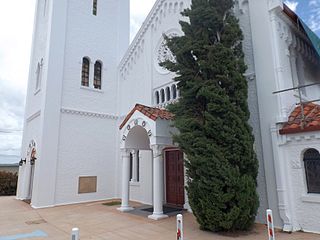
Holy Trinity Anglican Church is a heritage-listed Anglican church at 68 Hawthorne Street, Woolloongabba, Brisbane, Queensland, Australia. Since 1869, three church buildings have stood on this hill top site. The current church was completed in 1930. It was designed by the architect Eric Ford, featuring Romanesque and Spanish Mission Revival style architecture. Its preserved original architectural features make the church a traditional wedding venue of inner Brisbane. The church was added to the Queensland Heritage Register on 9 May 2008.
The 1963–64 Danish Cup was the 10th installment of the Danish Cup, the national association football cup competition in Denmark. This year's edition began with the regional qualifying rounds among the lower ranking members of the six regional governing bodies in early May 1963, and concluded with the grand cup final on 7 May 1964. A total of 707 clubs participated in the cup tournament – the highest number of teams since the cup's foundation. 671 teams were registered for the qualifying rounds, of which only 44 teams would quality for the proper rounds, under the auspices of the Danish FA's tournament committee, joined by 36 additional teams from the first, second and third divisions in the Danish football league system.
The 1964 Danish Cup final was a men's association football match between Esbjerg fB and Odense KFUM played at Københavns Idrætspark on 7 May 1964. It was the final match to determine the winner of the 1963–64 Danish Cup, the 10th season of the Danish national-wide annual football knockout competition, the Danish Cup, open to all DBU member clubs. This was the first time that two sides had ever met in a domestic cup competition and only the third time in a competitive league game. For Odense KFUM, the match represented their first opportunity to win a title on a national level, having never reached the quarterfinals in previous seasons in the cup's current incarnation, while Esbjerg fB were participating in their third cup final, having lost on both previous occasions. This was the third consecutive year the tournament's final featured a team from Odense.
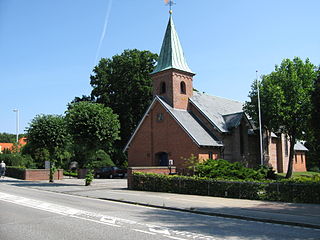
Humlebæk Church is a parish church in Humlebæk, Fredensborg Municipality, som 20 km north of central Copenhagen, Denmark.

Bredgade 63–65 are two identical Renaissance Revival style properties situated on Bredgade, adjacent to the small garden complex in front of Østre Landsret, in the Frederiksstaden of central Copenhagen, Denmark. Both buildings were individually listed in the Danish registry of protected buildings and places in 1988. The Mexican Embassy is based at No. 65.



















